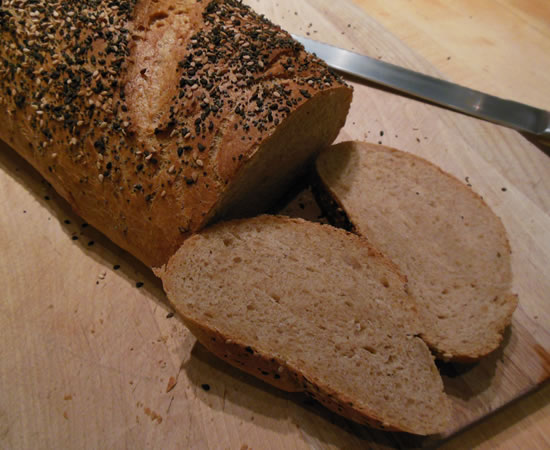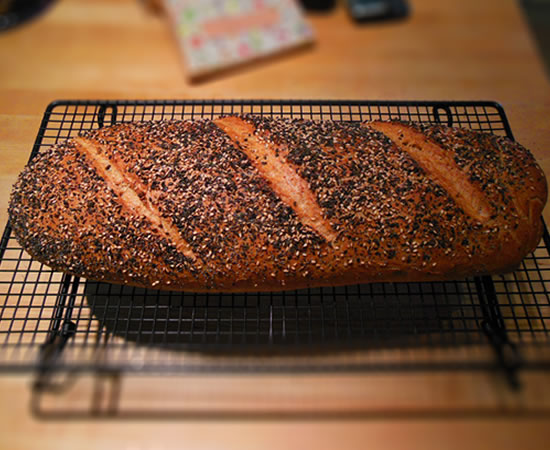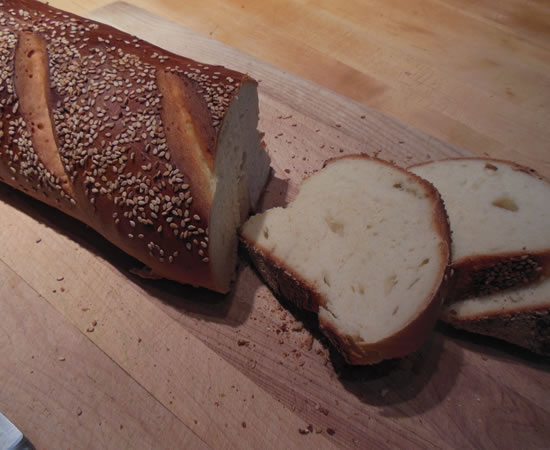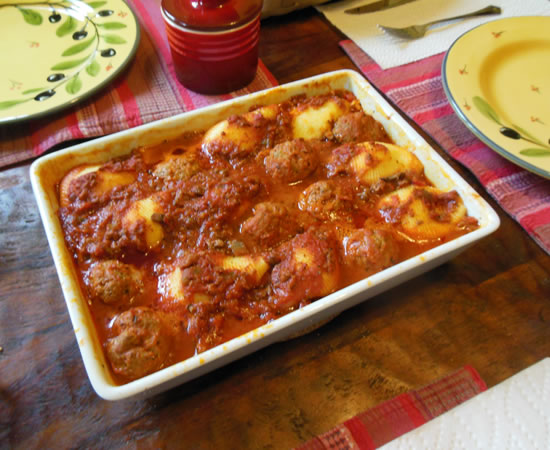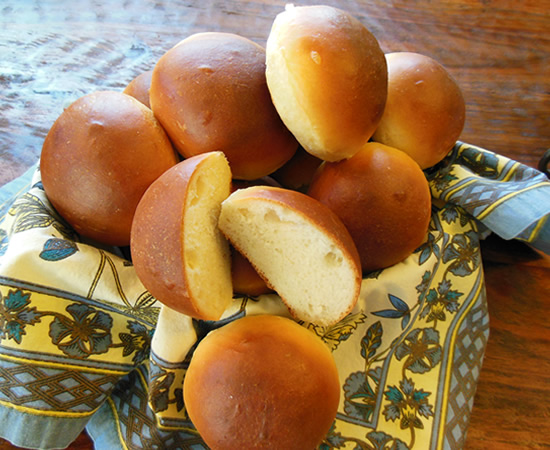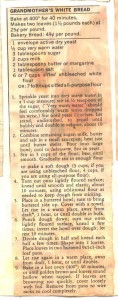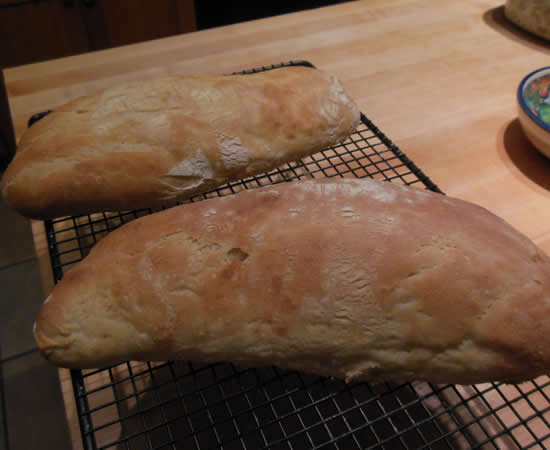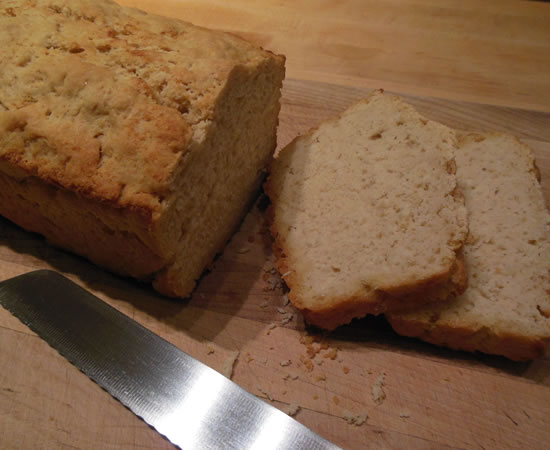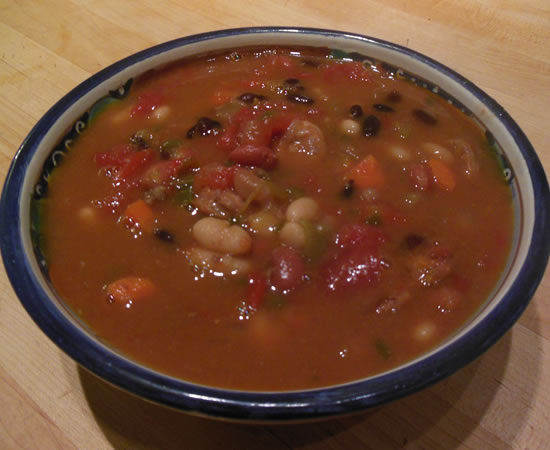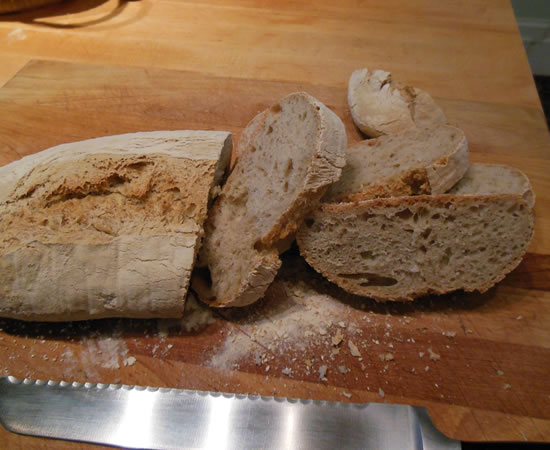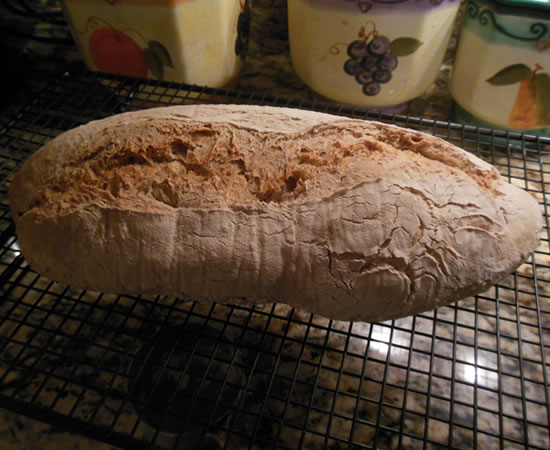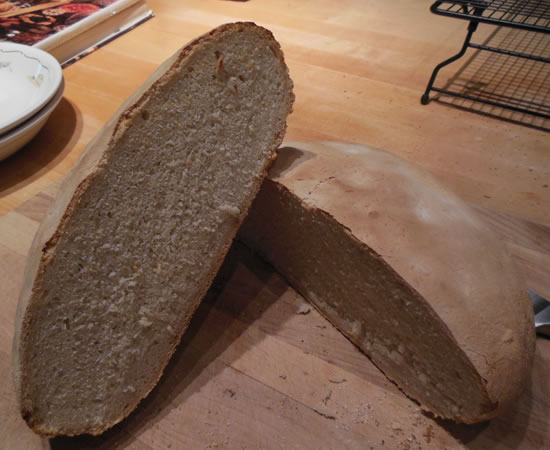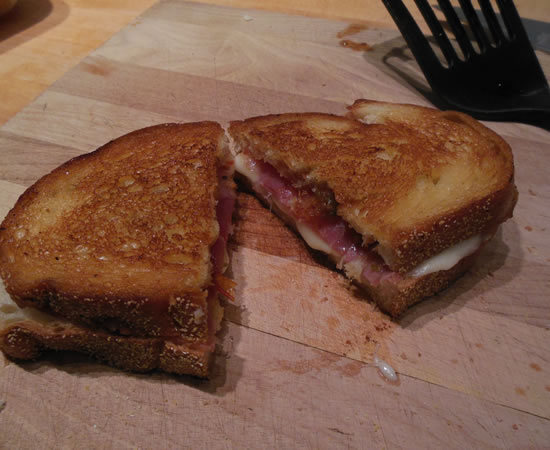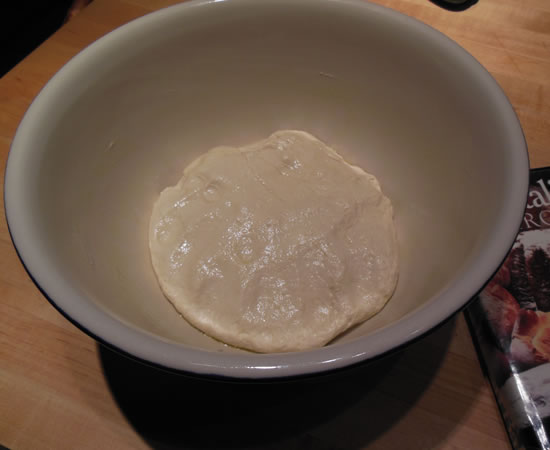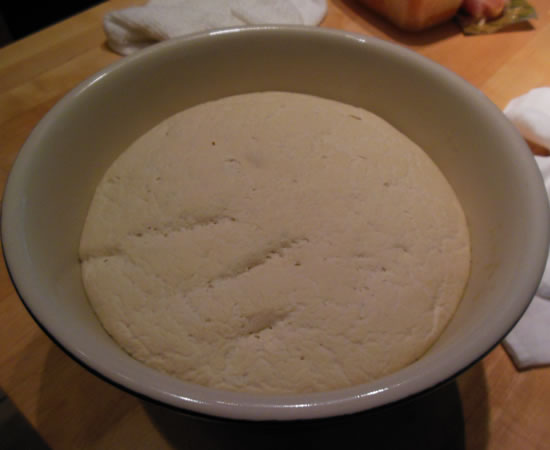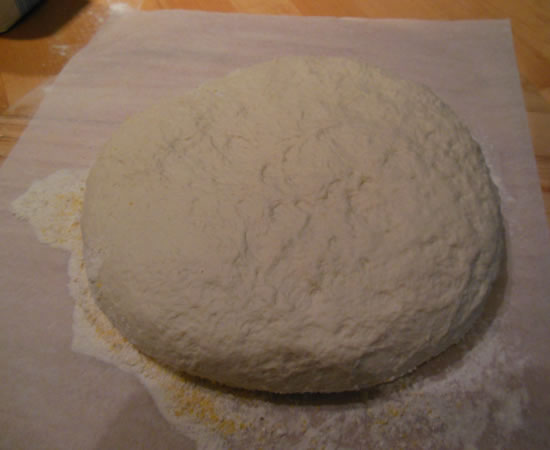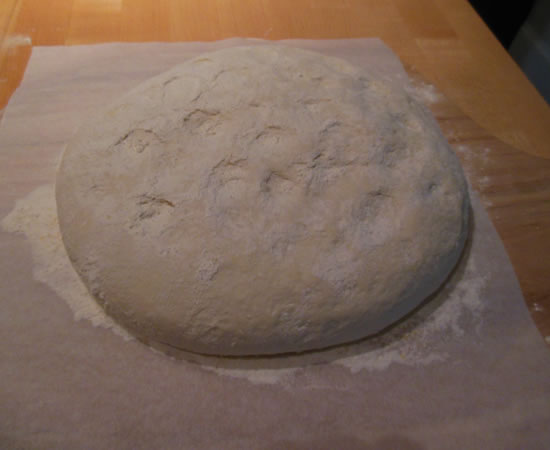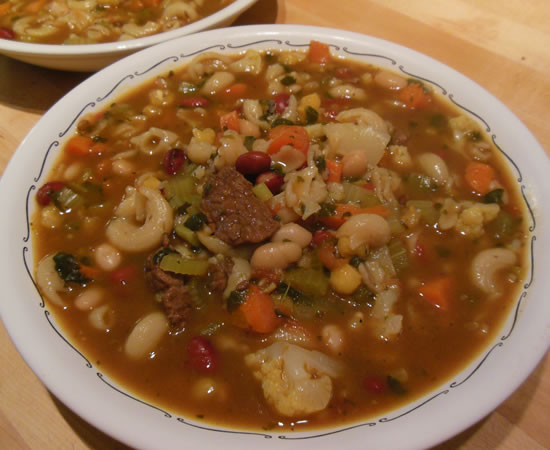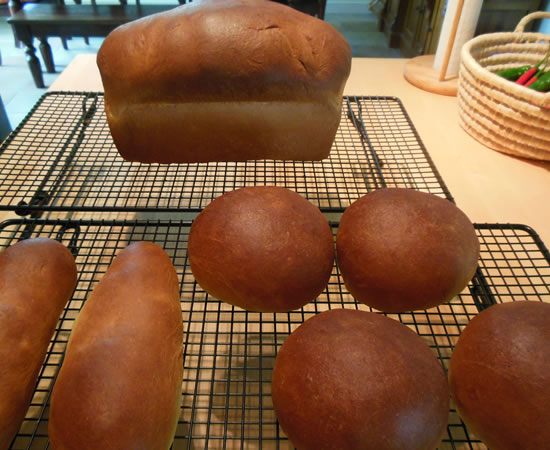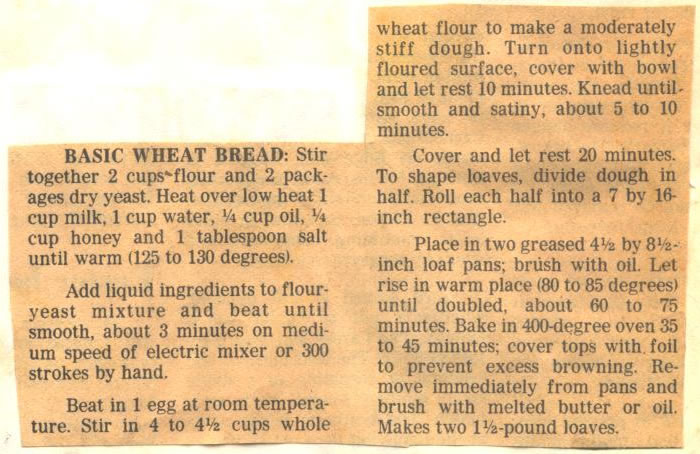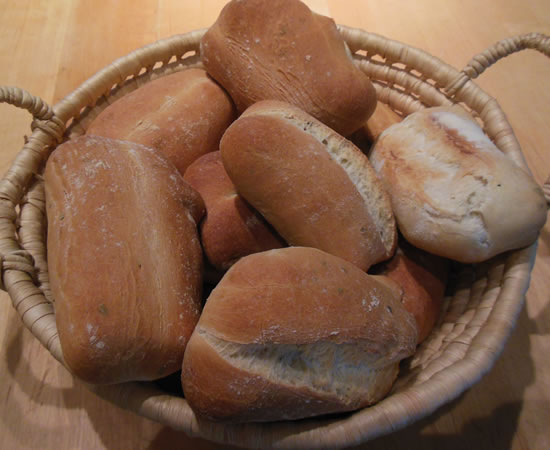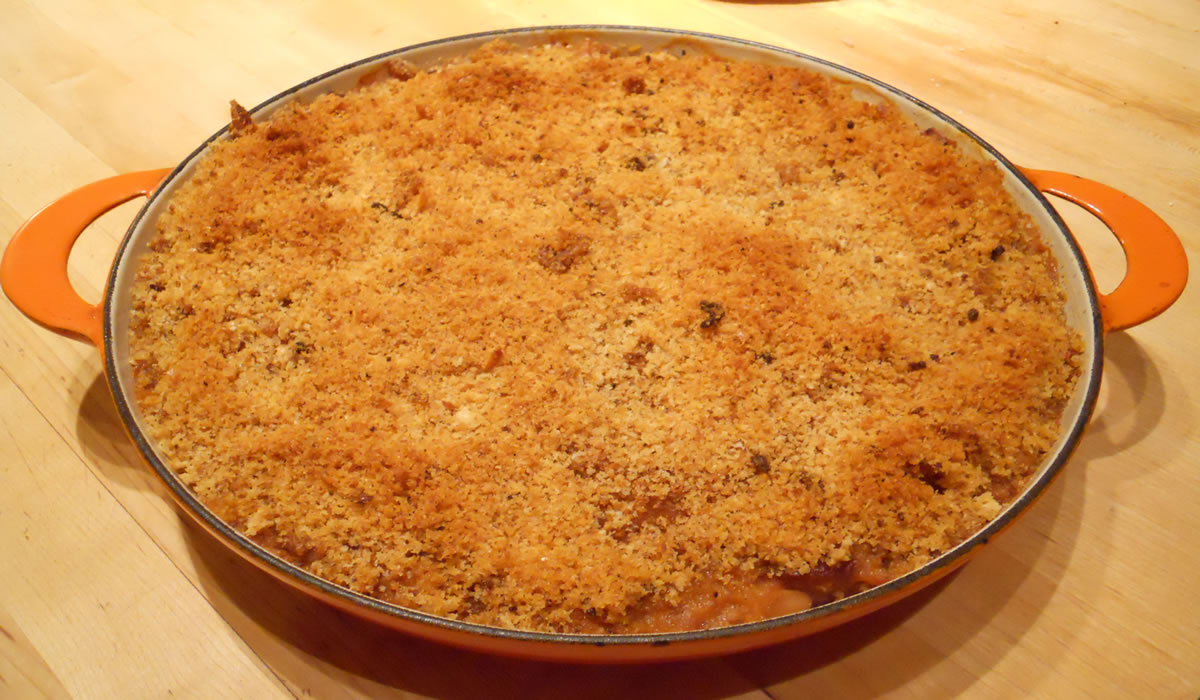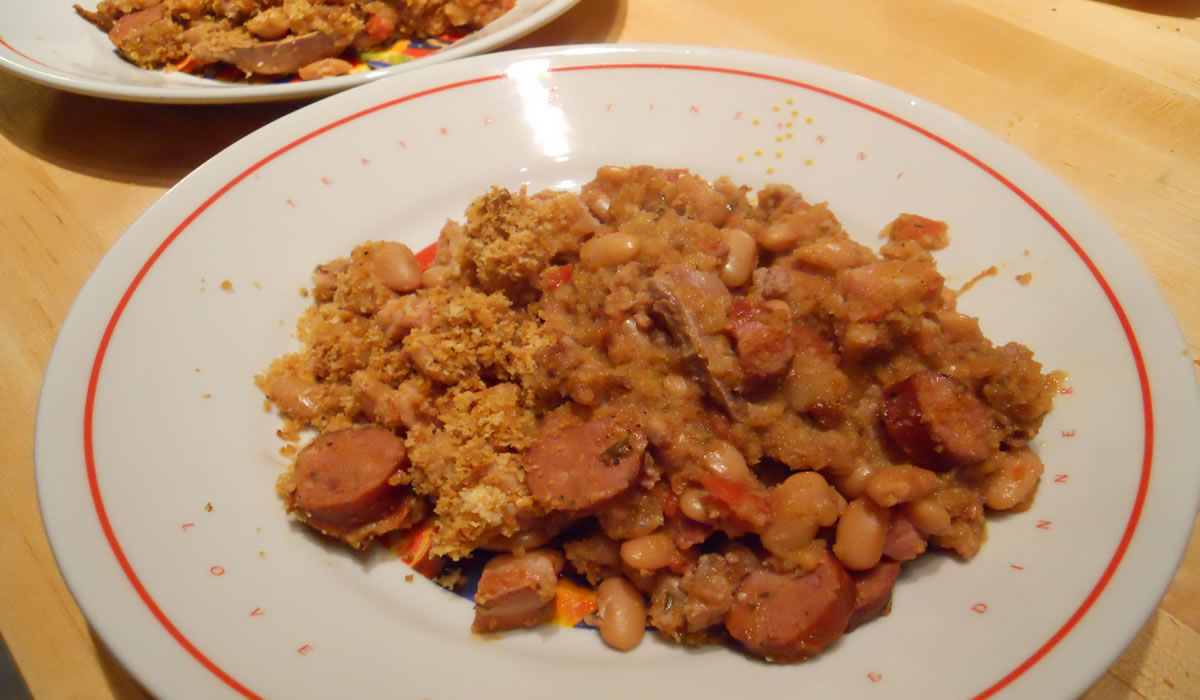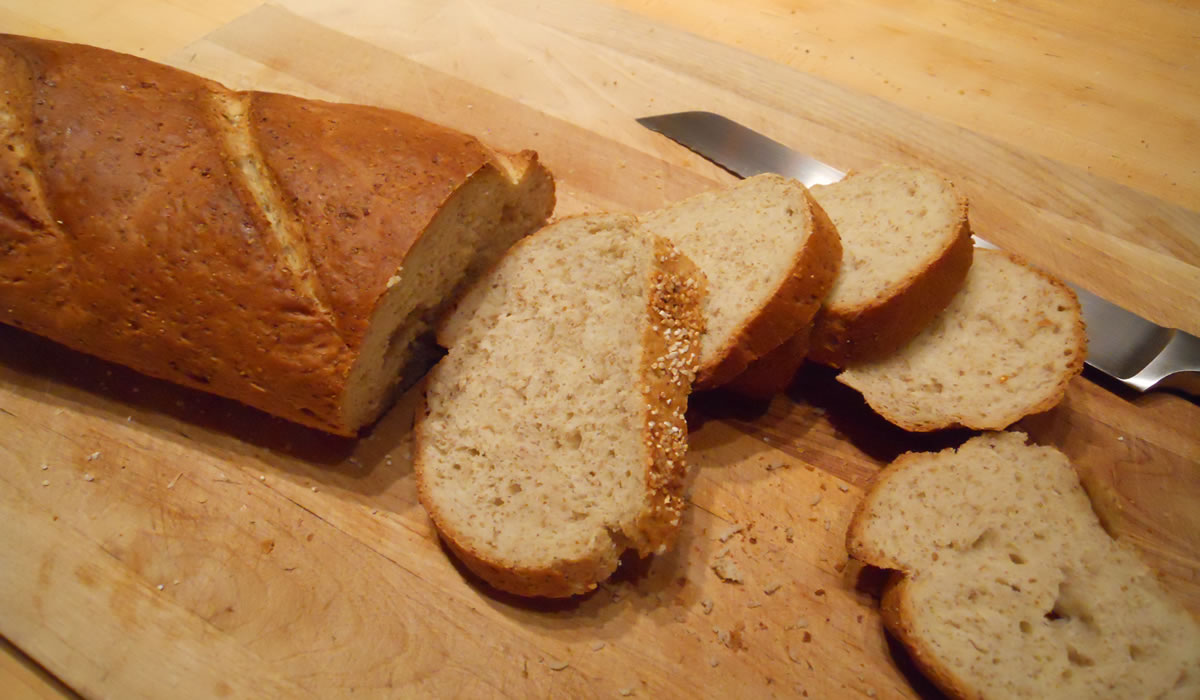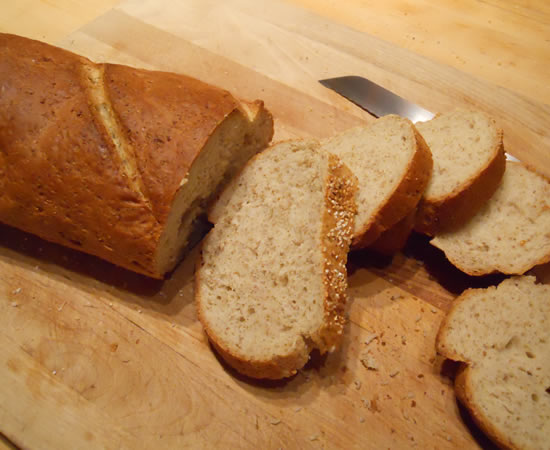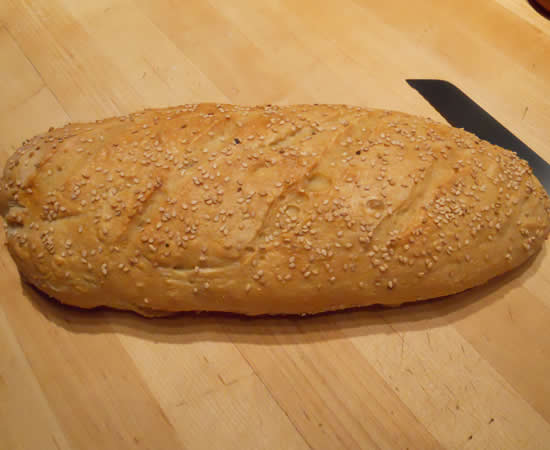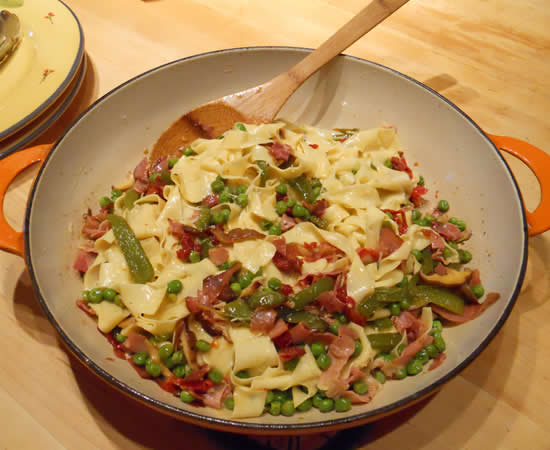Fresh Multi-Grain Bread
It's about a million degrees outside with a bazillion percent humidity. Perfect weather for baking bread.
Weather like this really is perfect for bread-baking. The heat and humidity make for Mother Nature's Perfect Proofing Box.
It's about the only positive thing I can think of about the weather. I'm a west coast wuss when it comes to humidity and heat. I just don't like it. And I hate living in air conditioning ::he says with the air blowing like there's no tomorrow:: I seem to hate the heat more.
I remember all those summers I spent in Bakersfield with my grandparents. We'd be outside playing in 100+° weather and the only cooling at grandma and grandpa's was an old swamp cooler in the living room. When it got up past 110° we'd head inside for Kool-aid or head out to Center Street Market for an ice-cold Coke if we had any money. It's amazing how a mere 55 years can change one's outlook. I'd die, today.
No Kool-aid and no Coke in the house nowadays, so it became time to bake bread.
The bread-baking happened because I saw fresh yeast at the grocery store this morning. Impulse-buy of the day. The recipe is a take-off of a Bob's Red Mill recipe. I changed things around to suit my own needs, but the basic recipe is sound.
And really really good. It's an easy one to pull together, so go for it.
Multi-Grain Seeded Bread
- 1/2 cup Grape-Nuts-type cereal
- 2 cups boiling water
- 2 1/4 tsp active dry yeast (or 4 1/2 tsp fresh)
- 2 1/2 - 3 cups unbleached white flour
- 1 tbsp olive oil
- 1 tbsp dark brown sugar
- 1 tsp salt
- 1 1/2 cups whole wheat flour
- 3 tbsp poppy and sesame seeds, mixed
Place the cereal in a large bowl, and pour the boiling water on top. Stir, and let it stand until the cereal and water cools to about 105°.
Sprinkle the yeast over the cereal and stir until the yeast is dissolved. Let stand until the yeast begins to foam, about 5 minutes.
Add 1 cup of the unbleached white flour to the cereal, along with the oil, sugar, and salt, and stir until smooth. Mix remaining flours and slowliy add. You may or may not need the remaining 1/2 cup. Cover the dough with a clean dish towel and let it rest for 15 minutes.
Turn the dough out onto a lightly floured board and knead until smooth and elastic, about ten minutes, adding more flour if it's sticky.
Lightly oil a large bowl, place the dough inside, turning it over in the oil, and cover with the dishtowel. Let the dough rise until it's doubles in size, about 1 hour.
Punch down the dough and turn it out onto a lightly floured surface. Knead for 3 to 4 minutes, then shape into a 12 x 4-inch loaf. Sprinkle a baking sheet with 2 teaspoons of the seed mixture and place the loaf on top of the seeds. Cover the dough with the dishtowel and let it rise until almost doubled, about 30 to 45 minutes.
Set one of the oven racks in the center of the oven and one just below the center. Place a baking pan on the lower rack and preheat the oven to 425°. Brush the dough with a little water and sprinkle with the remaining seed mixture. Using a sharp knife, cut 3 slashes across the top of the loaf. Place the baking sheet with the loaf in the oven and immediately pour 2 cups of water into the hot pan on the lower rack in the oven (water will steam).
Bake the loaf about 30 to 35 minutes. Transfer to rack and cool.
It had a beautifully-light crumb and a nice, crusty crust. Definitely one of my better loaves...
Slather it with butter. And forget about the heat.
Stuffed Shells and Fresh Bread
Since most of dinner, tonight, came out of the freezer, I had plenty of time to bake a loaf of bread. I have a few go-to recipes for bread but one of my all-time favorites is from James Beard. I actually have this recipe memorized. It is no-fail every time. It also lends itself to experimentation. I've switched out some of the flour for rye, buckwheat, or whole wheat, and have topped it with sesame seeds, poppy seeds, caraway seeds, and coarse salt.
It works no matter what.
Tonight was a basic white loaf with sesame seeds.
James Beard's French-Style Bread
Ingredients
- 1 package active dry yeast
- 2 tsp sugar
- 1 cup warm water (100° to 115°, approximately)
- 1 1/2 tsp salt
- 3 cups flour
- 1 egg, mixed with water
- sesame seeds
- 3 tbsp cornmeal
Directions
Combine the yeast with sugar and warm water in a large bowl and allow to proof. Mix the salt with the flour and add to the yeast mixture, a cup at a time, until you have a stiff dough. Remove to a lightly floured board and knead until no longer sticky, about 10 minutes, adding flour as necessary. Place in a buttered bowl and turn to coat the surface with butter. Cover and let rise in a warm place until doubled in bulk, 1½ to 2 hours.
Punch down the dough. Turn out on a floured board and shape into a long, French bread-style loaf. Place on a baking sheet that has been sprinkled with the cornmeal but not buttered. Brush loaf with egg wash and then liberally sprinkle with sesame seeds. Slash the tops of the loaf diagonally in three or four places. Place in a cold oven, set the temperature at 400° and bake 35 minutes or until well browned and hollow sounding when the top is rapped.
And then the freezer-meal. I had sauce, meatballs, and stuffed shells all done up from a while back. Those meatballs are finally running low - only one more container. I did use up the last container of sauce, so maybe I'll make a new batch of that tomorrow... The shells were actually store-bought. I need to make up a batch of them, too.
Nonna ate two shells and a meatball and skipped the bread. Her appetite has definitely improved since moving in. Unfortunately, so has mine - I didn't skip the bread. Or the butter.
Oh well. It all came out great and there's leftovers for lunch tomorrow...
And more cake, tonight!
Grandmother's Dinner Rolls
I wanted to make dinner rolls for tonight so I went to my mom's cook book for ideas. There is a treasure trove of recipes there just waiting to be rediscovered. And I found the perfect one for my rolls - Grandmother's White Bread.
It is a basic white bread recipe with milk and butter - both necessary for that soft crumb.
I made half the recipe and it made 12 good-sized dinner rolls.
After the first rise, I rolled the dough into a rope and divided it into 12 pieces. I then rolled each one into a ball and placed them on a parchment-lined sheet pan and after their second rise, baked them off for about 16 minutes in a 400° oven. I also brushed the tops with butter when they came out.
The result was a really light, buttery roll with a great crumb and great flavor.
And they took no time at all.
Chicken Soup and Ciabatta
Tonight's dinner was brought to you by a magazine ad for an Italian Soup. I looked at it and realized I had a chicken, a package of tortellini, and a better grasp of Italian cooking than the folks who came up with the ad.
I follow guidelines for certain soups, as when I make Mulligatawny, but really... soup is throwing stuff in a pot. It ain't brain surgery and it ain't difficult.
Canned and packaged soups rely on chemicals and flavor-enhancers for taste. Unfortunately, a lot of people only relate to the trickery that food manufacturers use in their products and feel underwhelmed when they make things at home - not understanding that real food without additives tastes different - and better. It becomes a retraining of the taste buds to learn how good individual foods taste and how well different foods blend together.
That being said, soup is still throwing stuff into a pot. As much or as little as you like.
Bread - and baking - takes a bit more science.
I've actually never made a ciabatta bread before and was glad my first attempt was from a trusted source. I used a recipe from The Italian Baker by Carol Field. The dough is quite unlike most bread doughs and she stresses several times not to succumb and add more flour than called for. It was good advice that I'm sure I would not have followed from other cook books. But I've been baking breads from her book for years and know when to pay attention.
The dough is quite wet and sticky so it does not translate to making by hand. Use a mixer. And really resist adding more flour. Really.
The biga needs to set out for 12 hours, so start the day before you want the bread.
Ciabatta Bread
for biga:
- 1/8 tsp active dry yeast
- 1 cup water at room temp
- 1 1/4 cup all purpose flour
Dissolve yeast in water, add the flour and form a sticky dough. Leave it covered at room temperature for 16 to 24 hours.
for the final dough:
- 3 tbsp warm milk
- 1 tsp active dry yeast
- 2/3 cup water
- 1 tbsp olive oil
- 1 cup biga
- 2 cups all-purpose flour
- 1/2 tbsp salt
Using a mixer, stir the yeast in the milk and let it stand for a couple of minutes in the bowl. Add the water, oil, the biga, and mix to incorporate, dissolving the biga in the liquid. Add the flour and salt, and mix at low speed for a couple of minutes. Change to the dough hook and knead 2 minutes at low speed, and 2 minutes at medium speed. Finish kneading by hand on a well-floured surface, but adding as little extra flour as possible.
Place the dough in an oiled bowl, cover, and leave at room temperature for about 1 hour and 15 minutes. Divide the dough, which will be very soft and bubbly, in two equal pieces. Place each half on a well floured piece of parchment paper, and shape each as a cylinder, keeping the seam side down. Stretch it gently to give the ciabatta overall shape (a rectangle of 10 x 4 inches), and use the tip of your fingers to make deep dimples all over the dough. Cover with a damp towel and let them rise for about 1 1/2 hours - not quite doubled in size.
Preheat oven to 425° with a baking stone. Right before placing the dough in, dust the stone with cornmeal. Gently roll the breads from the parchment onto the stone. Bake until the breads are golden brown, about 25 minutes, spraying them with water a few times during the first 10 minutes. Cool on racks.
I made chicken salad sandwiches with one of the loaves. You can get quite a few meals with a chicken and a bit of flour...
Beef Soup and Beer Bread
Last night was chicken soup and cornbread Tonight is beef soup and beer bread. With this %$@#& cold I have, the only thing that remotely sounds good is soup. I can throw stuff in a pot and walk away. Anything else is just too much of an effort.
It's not that I'm sick-sick, just snotty and tired. And Victor has started with a scratchy throat, too. This is just not the way to start the Storm of the Century.
The soup had a bit of everything in it:
- beef
- Mexican chorizo sausage
- canned tomatoes
- beef broth
- fresh longhorn peppers
- onions
- garlic
- great northern beans
- pinto beans
- black beans
- pink beans
- pimentos
- canned green chilis
- carrots
- salt & pepper
The combination of ingredients added all the herbs and spices it needed. I didn't add anything. It was mildly spicy and really rich. I let it boil for a while to reduce a bit.
The beer bread was my old standby. And I used up my last bottle of beer! Time to get more before the end of the world hits Sunday night.
This is truly one of the easiest breads to make - and it really does taste good.
Quick Beer Bread
- 3 cups self-rising flour
- 2 tbsp sugar
- 12 oz beer
- Melted butter
Mix and put into a 4″ x 8″ bread pan. Top with melted butter. Bake at 350° about 1 hour.
At least we're eating well... I have at least one more day of trying to get over this damned cold before returning to work...
Time for a cup of tea...
Pane di Como Antico
Last week when I baked my Pane Pugliese, I split the biga into several baggies and froze it for later use. I pulled one out of the freezer last night 'cuz I planned on making a loaf today. All seemed well... I chose Pane di Como Antico from Carol Field's Italian Baker cook book and bright and early, started making the bread.
The house was a bit chilly and I wasn't really concerned about the time it was taking to rise, since a slow, cool rise really makes for a more developed bread. But when it hadn't budged after 4 hours, I knew there was a problem. Back into the mixer it went, along with a pinch of yeast, and into a warm room.
While I'm not sure what the end result is supposed to be, I ended up with a really good loaf of bread!
A nice chewy crust and a nicely-textured crumb made for a great accompaniment to dinner!
Sadly, I had to throw out the remaining biga in the freezer. But... I'll make more! The biga needs to be made the day before you make the bread!
Another note is Carol Field specifies 1/4 cup of whole wheat flour but I like the flavor of rye flour, so I tend to use it when adding under a cup to a recipe.
Pane di Como Antico
adapted from The Italian Baker by Carol Field
Biga
- 1/4 tsp active dry yeast
- 1/4 cup warm water
- 1 1/4 cup water (room temperature)
- 3 3/4 cups unbleached all-purpose flour
Stir the yeast into the warm water and let stand until creamy – about 10 minutes. Stir in the remaining water and then the flour, one cup at a time.
Mix with the paddle attachment on the mixer at the lowest speed about 2 minutes.
Remove to a slightly oiled bowl, cover, and let rise at cool room temperature for 6 to 24 hours. The starter will triple in volume and still be wet and sticky when ready. Cover and refrigerate until ready to use.
Bread
- 3/4 c biga
- 3/4 cup water; At Room Temperature
- 1/4 cup rye flour
- 1 1/2 cups all-purpose flour
- 1 tsp salt
- Cornmeal
Mix the starter and water with the paddle in a large mixer bowl. Mix in the flours and salt. Switch to the dough hook and knead until softy and elastic, about 4 minutes. Finish kneading by hand on a lightly floured surface, sprinkling with additional flour, until smooth but still soft.
First Rise:
Place the dough in a lightly oiled bowl, cover with plastic wrap, and let rise until doubled, 1 1/2 to 2 hours. The dough is ready when it has numerous bubbles and blisters under the skin.
Shaping and Second Rise:
Divide the dough in half on a lightly floured surface without kneading it. Shape into a round loaf. Let it relax under a cloth for 20 minutes. Line baking sheet or peel with parchment paper and flour the paper generously. Roll ball into a fat cylinder and place seam side down on the paper. Dimple the loaf all over with your fingertips or knuckles, as for focaccia, to keep the dough from springing up. The dough should feel delicate but extremely springy.
Cover the loaf and let rise until doubled, with many visible air bubbles, 1 1/4 to 1 1/2 hours.
Baking:
Thirty minutes before baking, heat the oven with a baking stone in it to 425° . Sprinkle the baking stone with cornmeal. Very gently invert the dough onto the stone. Gently remove the parchment paper. Immediately reduce the heat to 400° and bake until golden, 35 to 40 minutes. Cool on wire rack.
Breakfast, Lunch, and Dinner
It was cold, wet, and rainy today. I knew this in advance and actually planned on being in the kitchen for most of the day. There really is no better place on a chilly day than next to a warm stove and hot oven. Well... there is, but ... uh... nevermind...
The day dawned with Victor making pancakes and bacon. Just what I wanted and just what I planned on making before he beat me to the kitchen. But I was looking to take them one step further - with a fried egg on top. I'm the egg man in the house, so I quickly fried up two of them after Victor finished his work and on they went. Midway through breakfast, Victor mentioned that he had never had a fried egg atop a pancake before! I was shocked! Heck, I've been cooking them and eating them since forever or longer.
The good news was that he really really liked them. I see more of them in our future...
After the breakfast dishes were cleared, I started on the bread. I had made my biga - starter - last night and had everything else in place. The bread recipe will follow.
After getting all of that cleaned up, it was lunch time.
Lunch was a simple grilled cheese sandwich. With fontina cheese, prosciutto, and homemade tomato pepper jam. On crusty Italian bread. It totally worked on every level.
And while the bread was rising and/or baking, I made soup.
Well... It started off as soup. It ended up being more stew-like. But damn! It was good!
It contained:
- chicken breasts
- andouille sausage
- onion
- celery
- carrots
- garlic
- chicken broth
- pumpkin puree
- white beans
- green chilis
- gold potatoes
- corn
- green beans
- peas
- black barley
- black lentils
- mahogany rice
- wild rice
- chipotle powder
- cayenne pepper
- salt
- pepper
I cooked the grains separately to try and keep the soup from thickening too much, but there was so much going on in that pot, it was impossible to keep the broth even remotely thin. It was good, because I was going for a thicker soup to begin with, but I just kept adding things and...
I made so much I brought a couple of containers over to our neighbors and will bring some to Victor's mom tomorrow when I do her shopping.
And we still have plenty for a couple more meals.
And around all this other cooking, I baked one of my more favorite Italian breads - Pane Pugliese.
I usually make all of the biga and freeze what I don't use, but only make half of the bread recipe.
I also decided to use my Italian "00" flour. It is noticeably different both in taste and texture. I needed to add a bit more flour than normal, but the bread came out perfect. A really chewy crust and a delicate crumb.
Pane Pugliese
adapted from The Italian Baker by Carol Field
- 1 packet dry yeast (or 1/2 package fresh yeast)
- 1/4 cup warm water
- 3 cups water; room temp
- 1 cup biga
- 7 1/2 cups all-purpose flour
- 1 tbsp salt
Proof the yeast in the warm water. Add 1 1/2 c water and the biga, mix till blended. Add flour and salt, mix till dough comes together and pulls off the sides of the bowl. Knead 3-5 minutes in a mixer, longer by hand. Dough will be very soft and elastic. Let rise about 3 hours, shape into 2 small round loaves or 1 big flattish one. If you have baking stones, place loaves on baking peel or on baking sheets sprinkled corn meal. Let rise about 1 hour. Preheat oven to 450°, and 10 minutes before baking flour the loaf tops and dimple them with your fingers. Bake 50-60 minutes for big loaves, 30-35 minutes for small. Tap the loaves to test for doneness (hollow=done) and cool on a rack.
Here's the biga last night after being mixed.
Biga
- 1/2 tsp active dry yeast (or 1/10 package fresh yeast)
- 1/4 cup warm water
- 1 1/4 cup water (room temperature)
- 3 3/4 cups unbleached all-purpose flour
Stir the yeast into the warm water and let stand until creamy – about 10 minutes. Stir in the remaining water and then the flour, one cup at a time.
Mix with the paddle attachment on the mixer at the lowest speed about 2 minutes.
Remove to a slightly oiled bowl, cover, and let rise at cool room temperature for 6 to 24 hours. The starter will triple in volume and still be wet and sticky when ready. Cover and refrigerate until ready to use.
And then what it was like 12 hours later.
This is the bread after its first rise. I had just formed it into the loaf.
And then, after flouring and dimpling the dough 10 minutes before going into the oven.
If you bypass this step, the bread will literally go wild in the oven. This knocks out a lot of the gas and makes for a very fine crumb.
Homemade Bread and Soup
The weather was juuuuust cool enough yesterday to warrant a pot of soup and a loaf of bread. Every season has its food benefits, but Fall has soups and stews - some of my favorite things. Soups around here are clean-out-the-refrigerator meals, for the most part. While I do have a few soups that call for specific ingredients, they usually are concoctions of what is in the house. They're fun, because they're never quite the same from batch to batch.
I strained that big batch of pumpkin puree and had close to a quart of pumpkin juice left. (I drained it overnight in a cheesecloth-lined colander.) That went into the broth right off the bat. Along with some beef, beef broth, carrots, rice, black and white barley, celery, beans, tomatoes, cauliflower, garlic, spinach, yellow hominy, and pasta. I added a bit of French herbs, salt, and pepper.
It came out great.
And then we had a great loaf of bread...
It's a really easy James Beard recipe I've used for years. And years. Really versatile, I braided this loaf and added the sesame seeds.
James Beard French-Style Bread
Ingredients
- 1 package active dry yeast
- 2 tsp sugar
- 1 cup warm water (100° to 115°, approximately)
- 1 1/2 tsp salt
- 2 1/2 cups bread flour
- 1/2 cup rye flour
- 3 tablespoons yellow cornmeal
- 1 egg white, mixed with 1 tablespoon cold water
Directions
Combine the yeast with sugar and warm water in a large bowl and allow to proof. Mix the salt with the flour and add to the yeast mixture, a cup at a time, until you have a stiff dough. Remove to a lightly floured board and knead until no longer sticky, about 10 minutes, adding flour as necessary. Place in a buttered bowl and turn to coat the surface with butter. Cover and let rise in a warm place until doubled in bulk, 1½ to 2 hours.
Punch down the dough. Turn out on a floured board and shape into a long, French bread-style loaf. Place on a baking sheet that has been sprinkled with the cornmeal but not buttered. Slash the tops of the loaf diagonally in two or three places, and brush with the egg wash. Place in a cold oven, set the temperature at 400°, and bake 35 minutes, or until well browned and hollow sounding when the top is rapped.
It takes no time at all to make and always is a hit!
I see a lot more of this in our future...
Bread and Rolls
What's the old adage... When life hands you lemons, make lemonade?!? That's kinda how today is...
We had plans for a fun day with friends and Victor threw his back out last night. Not good. And definitely not up for an hour drive in the car.
Regroup.
Now having to plan a couple of meals I wasn't planning on cooking, I took stock of the larder; plenty of food, lots of sandwich-fixin's - but no bread. My choice was to drive the mile to the grocery store and buy a loaf - or bake some. It's not everyone who will think it's easier to bake a loaf of bread than run to the store, but, for me, not having to deal with a grocery store on a Saturday is a good thing. Besides, have you ever looked at the ingredient list on a basic loaf of grocery store bread?!? Yuck.
So out came Mom's trusty cook book.
She had a recipe for a basic wheat bread that I default to whenever I want a quick couple of loaves. It is really good, really easy, and pretty quick to pull together. I really haven't been making a lot of loaves of bread, lately. They have been mostly free-form rustic breads. I thought it time to break out the loaf pans and have at it.
The recipe calls for two loaves and I knew we'd never go through them before it went stale, so I decided one loaf and a few rolls would work.
I started the process, went to get the whole wheat flour - and noticed there wasn't any! I had rye, buckwheat, graham, whole wheat pastry, and unbleached cake, all-purpose, and bread flours. No whole wheat. Whole wheat bread became white bread. I'll live with it.
I followed the recipe as written, except I used the bread flour and omitted the egg.
I baked the rolls for about 20 minutes and the bread for maybe 38 minutes. It also rose a lot faster today than usual - white flour will generally rise quicker than a more-dense wheat, anyway - but it's hot and muggy outside... the perfect summer proofing box.
It all came out great. Perfectly light, really flavorful, lots of body - and the long rolls were perfect for leftover sausage and peppers.
A Basket of Italian Rolls
I picked up an old copy of La Cucina Italiana the other day, and marveled at all the things I hadn't yet made. So many recipes, so little time.
But last night, after getting home late from having dinner with friends, I made a poolish for some herbed rolls. I'm off on Monday and have the time to play in the kitchen a bit more...
A poolish - for those who are not Italian or French bakers - is another name for a starter. It's a bit wetter than a biga - which is also a starter. It's flour, water, and a pinch of yeast left out overnight - a pre-fermentation starter.
And since I had two bags of Italian "00" flour, out it came.
I had to play with the recipe a bit because my flour was much drier than a basic all-purpose, but the rolls came out pretty good. In fact, Victor ate one as a sandwich for lunch and raved about it. And then had another with dinner - along with more raves.
Panini con erbe aromatiche
Herb Bread Rolls
adapted from La Cucina Italiana MagazineIngredients
Poolish
- 1 cup unbleached all-purpose flour
- 1/2 cup tepid water
- 1/2 teaspoon active dry yeast
Dough
- 3 1/2 cups unbleached all-purpose flour plus more for dusting
- 3/4 cup plus 1 1/2 tablespoons warm water
- 2 tablespoons extra-virgin olive oil
- 1 teaspoon fine sea salt
- 1 3/4 teaspoons finely chopped mixed herbs, such as oregano, rosemary and thyme
Instructions
Poolish: In a bowl, stir together flour, water and yeast. Let mixture stand at room temperature at least 10 hours or overnight.
Dough: Add flour, water, oil and salt to poolish; mix together to form dough. Turn out dough onto a clean surface and knead until smooth and elastic, about 5 minutes.
Stretch and pat out dough into a 10-inch square and sprinkle with herbs. Knead, 1 minute, to incorporate herbs. Form dough into a ball, then transfer to a large bowl. Cover bowl with a clean, damp dishtowel and let dough rise, in a draft-free place at warm room temperature, until doubled in bulk, about 1 hour.
Spread a clean, dry dishtowel on work surface. Dust work surface and dishtowel with flour. Divide dough into 12 equal pieces; roll each piece into a ball. Cover balls with a clean damp dishtowel and let rest, 10 minutes. On work surface, stretch one ball into a 2- x 8-inch rectangle. With short side of rectangle facing you, fold bottom edge to center, then fold top edge to center. Press firmly with fingertips to seal seams, then fold in half, folding bottom edge over top. Pinch together all seams, then gently roll dough to create a 5-inch-long loaf.
With the edge of your hand, firmly press center of loaf to create a deep indentation. Transfer loaf to prepared dishtowel. Repeat with remaining dough. Sprinkle flour over indentations, then cover loaves with a second clean, dry dishtowel. Let rise, in a draft-free place at warm room temperature, 25 minutes.
Heat oven to 450° with rack in middle. Line two baking sheets with parchment paper. Arrange loaves on baking sheets. One batch at a time, bake rolls until deep golden, about 20 minutes. Let rolls cool on a wire rack at least 10 minutes before serving.
I used fresh thyme and oregano and the herb flavor was barely perceptible. You could easily go for a full tablespoon of minced fresh herbs with no problem.
But the rolls, themselves were really good. They shall stay in the repertoire!
Cassoulet and Fresh-Baked Bread
I have been thinking about a cassoulet for months. A real cassoulet - with duck confit and everything.
Today, I made my cassoulet!
In its most base form, a cassoulet is French baked beans. But - in true French style - the lowly bean is elevated to dizzying gastronomical heights.
It is a treat, indeed.
There are probably as many recipes for cassoulet in France as there are ravioli in Italy, so I didn't feel the need to strictly follow any one recipe. I went for a bit more technique than strict ingredients, but the end result was just fine.
The recipe here is from Gourmet magazine from about 10 years ago. I changed it by using canary beans instead of white, adding about 8 ounces of Ventreche - French pancetta - and only using one duck leg. I also cut the water back to 5 cups to start, along with the 2 cups of broth. I didn't have any parsley, either, and didn't feel like getting dressed and going to the store. (Damned cold!!)
But parsley or no, it came out just fine.
Cassoulet
- 1 lb dried white beans (preferably Great Northern)
- 8 1/4 cups cold water
- 2 cups beef broth
- 1 tablespoon tomato paste
- 2 cups chopped onion (3/4 lb)
- 3 tablespoons finely chopped garlic (6 large cloves)
- 1 (3-inch) piece celery, cut into thirds
- 3 fresh thyme sprigs
- 1 Turkish or 1/2 California bay leaf
- 3 whole cloves
- 3 fresh flat-leaf parsley sprigs plus 1/2 cup chopped leaves
- 1/4 teaspoon whole black peppercorns
- 1 (14-oz) can stewed tomatoes, puréed or finely chopped with juice
- 4 confit duck legs (1 3/4 lb total)
- 1 to 2 tablespoons olive oil (if necessary)
- 1 lb cooked garlic pork sausage* or smoked pork kielbasa, cut crosswise into 1/3-inch-thick slices
- 2 cups coarse fresh bread crumbs (preferably from a baguette)
- 1 1/2 teaspoons salt
- 1/2 teaspoon black pepper
preparation
Soak and cook beans
Cover beans with cold water by 2 inches in a large bowl and soak 8 to 12 hours. Drain in a colander.
Transfer beans to a 6- to 8-quart pot and bring to a boil with 8 cups cold water, broth, tomato paste, onion, and 2 tablespoons garlic. Put celery, thyme, bay leaf, cloves, parsley sprigs, and peppercorns in cheesecloth and tie into a bundle with string to make a bouquet garni. Add bouquet garni to beans, then reduce heat and simmer, uncovered, until beans are almost tender, 45 minutes to 1 hour. Stir in tomatoes with juice and simmer until beans are just tender, about 15 minutes more.
Prepare duck and sausage while beans simmer:
Remove all skin and fat from duck legs and cut skin and fat into 1/2-inch pieces. Separate duck meat from bones, leaving it in large pieces, and transfer meat to a bowl. Add bones to bean pot.
Cook duck skin and fat with remaining 1/4 cup cold water in a 10-inch heavy skillet over moderate heat, stirring, until water is evaporated and fat is rendered, about 5 minutes. Continue to cook, stirring frequently, until skin is crisp, 3 to 6 minutes more. Transfer cracklings with a slotted spoon to paper towels to drain, leaving fat in skillet. (You should have about 1/4 cup fat; if not, add olive oil.)
Brown sausage in batches in fat in skillet, then transfer to bowl with duck meat, reserving skillet.
Preheat oven to 350°F.
Make bread crumb topping:
Add remaining tablespoon garlic to fat in skillet and cook over moderate heat, stirring, 1 minute. Stir in bread crumbs and cook, stirring, until pale golden, about 2 minutes. Remove from heat and stir in chopped parsley, 1/2 teaspoon salt, 1/4 teaspoon pepper, and cracklings.
Assemble casserole:
Remove bouquet garni and duck bones from beans and discard, then stir in kielbasa, duck meat, remaining teaspoon salt, and remaining 1/4 teaspoon pepper.
Ladle cassoulet into casserole dish, distributing meat and beans evenly. (Meat and beans should be level with liquid; if they are submerged, ladle excess liquid back into pot and boil until reduced, then pour back into casserole dish.) Spread bread crumb topping evenly over cassoulet and bake, uncovered, in lower third of oven, until bubbling and crust is golden, about 1 hour.
It really worked on every level. Rich, flavorful, creamy, meaty, and filling. I was surprised at just how much duck meat was on that one leg and I still got a fair amount of cracklin's for the bread crumbs. More would have been nice - but what I had worked.
And a big cassoulet called for a fresh loaf of bread. I went to my lazy-man's loaf - James Beard's French Loaf - his Cuban bread. I tweaked it a bit and added a bit of rye flour . Came out excellent!
His original recipe makes two loaves. I cut it down for one.
James Beard French-Style Bread
Ingredients
- 1 package active dry yeast
- 2 tsp sugar
- 1 cup warm water (100° to 115°, approximately)
- 1 1/2 tsp salt
- 2 1/2 cups bread flour
- 1/2 cup rye flour
- 3 tablespoons yellow cornmeal
- 1 egg white, mixed with 1 tablespoon cold water
Directions
Combine the yeast with sugar and warm water in a large bowl and allow to proof. Mix the salt with the flour and add to the yeast mixture, a cup at a time, until you have a stiff dough. Remove to a lightly floured board and knead until no longer sticky, about 10 minutes, adding flour as necessary. Place in a buttered bowl and turn to coat the surface with butter. Cover and let rise in a warm place until doubled in bulk, 1½ to 2 hours.
Punch down the dough. Turn out on a floured board and shape into a long, French bread-style loaf. Place on a baking sheet that has been sprinkled with the cornmeal but not buttered. Slash the tops of the loaf diagonally in two or three places, and brush with the egg wash. Place in a cold oven, set the temperature at 400°, and bake 35 minutes, or until well browned and hollow sounding when the top is rapped.
I do have to admit that we ate well, tonight.
Now... if this damned cold would just go away...
Tagliatelle Fresche and Fresh-Baked Bread
It's another Saturday and I came home to another feast! Homemade pasta and homemade bread. It just doesn't get any better!
The pasta was Victor's famous tagliatelle. The bread was from James Beard.
The pasta is so light but so full of flavor and texture. It can withstand any type of sauce, but I just love it when Victor grabs whatever out of the 'fridge and creates! Tonight he took olive oil, sun-dried tomatoes in oil, oyster mushrooms, bell pepper, peas, and prosciutto, sauteed it all and then stirred in the cooked pasta and sprinkled some freshly-grated cheese on top.
Did I mention perfection?!?
Perfection.
This is a half-batch of the pasta recipe.
Tagliatelle Fresche
Ingredients
- 1 cup unbleached all-purpose flour
- 1 large egg
- 1 large egg yolk
- Coarse sea salt
Instructions
On a clean work surface, mound flour and form a well in the center. Add egg and egg yolk to the well. Using a fork, gently break up yolks and slowly incorporate flour from inside rim of well. Continue until liquid is absorbed, then knead for 10 minutes. Wrap dough tightly in plastic and let rest for 30 minutes.
Divide dough into 3 pieces. Cover 2 pieces with plastic wrap. Flatten remaining dough piece so that it will fit through the rollers of a pasta machine.
Set rollers of pasta machine at the widest setting, then feed pasta through rollers 3 or 4 times, folding and turning pasta until it is smooth and the width of the machine.
Roll pasta through machine, decreasing the setting, one notch at a time (do not fold or turn pasta), until pasta sheet is scant 1/16 inch thick.
Cut sheet in half widthwise; dust both sides of sheets with flour. Layer sheets between floured pieces of parchment or wax paper. Cover with paper and repeat with remaining dough.
With the short end of 1 pasta sheet facing you, loosely fold up sheet, folding sheet over two or three times from short ends toward the center. With a large chefs knife, cut folded sheet into ribbons, a scant 1/4 inch wide. Unroll strips and lightly dust with flour; spread on a lightly floured baking sheet. Repeat with remaining pasta sheets.
To cook the tagliatelle, bring a large pot of salted water to a boil. Add pasta and cook until tender, about 3 minutes. Drain pasta, transfer to a large serving bowl and toss with sauce.
And then, just because perfect pasta wasn't enough, he made a loaf of one of my favoriote breads!
This comes from the Beard on Bread cook book by James Beard. It's quick and reasonably difficult to screw up!
James Beard French-Style Bread
- 1 1/2 pk active dry yeast
- 1 tbsp sugar
- 2 cups warm water (100-115 deg.)
- 1 tbsp salt
- 5-6 cups all-purpose or hard wheat flour
- 3 tbsp Yellow cornmeal
- 1 egg white mixed with 1 tbsp cold water
Combine the yeast with sugar and warm water in a large bowl and allow to proof. Mix the salt with the flour and add to the yeast mixture, a cup at a time, until you have a stiff dough.
Remove to a lightly floured board and knead until no longer sticky, about 10 minutes, adding flour as necessary.
Place in a buttered bowl and turn to coat the surface with butter. Cover and let rise in a warm place until doubled in bulk..1 1/2-2 hrs.
Punch down the dough. Turn out on a floured board and shape into two long, French bread-style loaves. Place on a baking sheet that has been sprinkled with the cornmeal, but NOT buttered.
Slash the tops of the loaves diagonally in two or three places with a single edge razor blade or sharp knife, brush the loaves with the egg white wash.
Place in a COLD oven, set the temperature at 400° and bake 35 minutes, or until well browned and hollow sounding when the tops are tapped.
The meal was perfection all the way.

